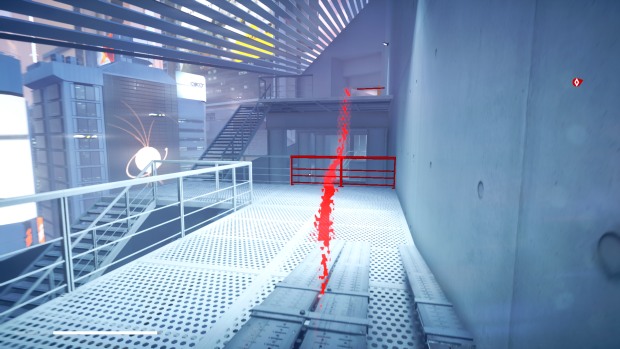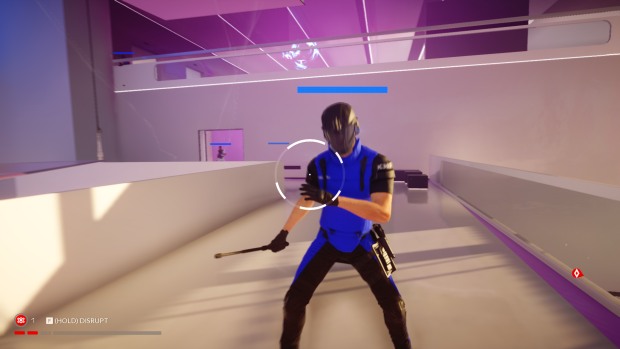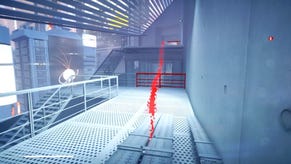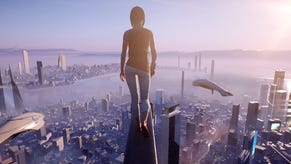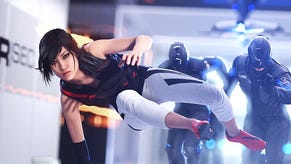Wot I Think: Mirror's Edge Catalyst
Same old joys, same old flaws
The original Mirror's Edge landed in 2008 like a breath of fresh air. Gears of War had released two years prior and all the games in the world seemed suddenly to be brown third-person shooters about crouching. By comparison Mirror's Edge, about a secret postwoman in an anti-utopia, had blue skies, interior decorating that favored orange and lime green, and a focus on leaping over walls rather than hiding behind or firing bullets around them. It had many flaws, but for me its aesthetic and the satisfaction of its free-running movement made it worth championing.
Eight years later and now we have not a sequel but a reboot in Mirror's Edge Catalyst. You are still secret postwoman Faith Connors bounding across rooftops in a dystopic city called Glass; your parents were still killed in protests when you were young; you still had a sister and still have an older, male mentor who trains you in running. Your moveset is mostly an unchanged combination of leaps, slides, wallruns, walljumps and swings. Sadly, many of the same old problems remain too, which we'll get to.
What's most clearly changed is that Catalyst is open world where its predecessor was linear. Missions are now found and take place within explorable districts of the city of Glass, which unlocks in a hub structure as you progress through the story. I love this change, for two reasons. One is that it injects some actual delivery work into a world about delivery people via side missions, where the original had none. There's plenty to do in Catalyst and though more of it is time trials than I'd like (and that I'm no good at), I appreciate extra reasons to be in that world.
The second reason I love the change is that it allows you to be in that world for no reason at all, to run for the pure pleasure of running. Catalyst's greatest strength is still the feeling of movement. The pit-pat, pit-pat of my feet against concrete builds until I start to hear the whoosh of wind past my ears as I reach top speed, and then I'm gone, lost in the flow of the game. Slide under that vent, leap over the next, use a box as a springboard to reach a high platform, rebound off a wall to grab a ledge behind me, grab a zipline and repeat. It's exhilarating.
These moves are now unlocked via a progression system, in which you put unlock points towards combat, movement or gear upgrades. It'll take you an hour to regain Faith's moveset from the first game. After that, in terms of movement, you'll unlock a grappling hook and new abilities for it. The grapple is fun to use, especially when you're swinging or drawing yourself up large distances between buildings at speed, though it only attaches to fixed points within the environment and there's not too many of them. That's probably for the best given its potential to undermine the rest of your methods of navigation. Its worst attribute is a late-stage addition that allows you to use it to pull down obstacles, which feels somewhat pointless - an unnecessary extra open door button.
The feeling of flow is helped by Runner Vision, the game's dynamic method for highlighting routes in red and guiding you via a wispy red line snaking across scenery. Runner Vision won't always highlight the fastest route but it means you never need to think, instead free to just run.
Unfortunately I think Runner Vision hurts other parts of the game. Free-running into a zen state was only one of Mirror's Edge's movement-related pleasures. The other was its vast atriums, in which you were dropped at the bottom of some skyscraper or another and challenged to find your way upwards. These were a kind of puzzle and required your active study of the environment. Catalyst still contains these moments in missions, where it will disable Runner Vision and leave you to find your own path.
They're few and far between, however, and in the rest of the game, especially when navigating between city districts, Runner Vision is practically essential. To the point where it becomes overbearing. After a couple of hours of play, I realised that I had been flowing seamlessly across the world without ever stopping to admire the Corbusier-inspired architecture underfoot, the gleaming white of the futuristic skyline in the distance, or anything in between. Free-running is meant to be about engaging with your environment in a new and empowering way, but I was engaging with that wispy red line more than anything else.
You can turn it off thankfully, but be prepared if you do to get hopelessly lost. I played much of the game this way and it did indeed make me pay more attention to the level design - which is frequently wonderful, and well worth your attention - but it also revealed that there's very little visual signposting baked into the world. Without Runner Vision, it's hard to tell which doors can be barged and which can't, for example. You'll also suddenly realise that the open world isn't so open and that there are only single routes connecting each district (presumably to disguise the loading of a new area in the background), and that trying to navigate based solely on the distant objective marker rising into the sky will simply see you finding dead-end after dead-end. In the latter case, for example, a mission underground will simply lead you to the point on the surface above the mission start. Finding your way down below will mean finding an entrance which might be a mile away, with no sign of how to get there unless you turn on the aids in the menu.
There's a halfway house in the form of 'classic' Runner Vision, which only highlights objects for use along your route without that wispy line, but that's not what I want. Instead I want objective markers along my route that give me something closer to aim for while still maintaining the challenge of how to get there.
I settled for the uneasy compromise of turning the mode on and off manually at frequent points throughout the game. It's just one of the ways in which Catalyst seems like a game of uneasy compromises.
For another: combat is back. The most maligned part of the first game was its harassing enemies and weak gunplay. This time things have been retooled so you can no longer pick up weapons, and instead have a set of melee attacks which work best when you maintain momentum. I never wanted a Mirror's Edge game without any combat at all and there are moments when the new system works well, when you leap off a building a knock out an enemy in a single pounce, or best of all sprint through a crowd of shooting enforcers unharmed because maintaining momentum gifts you invincibility.
The rest of the time combat is as big a pain as it ever was. You can combine strong and light attacks, exploit moments in which your opponent is stunned, bump them into one another, bounce off the environment for stronger hits, and knock people over ledges, but none of these things feels fun to do. Animations are slow and the game occasionally struggles to sync up different character movements, robbing you of strikes. The rest of the time, it cheats. Kick an enemy towards a railing and he'll move slowly towards it then dramatically throw himself into it, like a stunt actor trying to sell a strike more than it was worth. Enemies cheat similarly in their attacks against you, with bullets sometimes coming out of their backs and high kicks auto-targeting towards you even as you strafe out of their way.
There's also, as now seems traditional, an enemy type that'll have you slamming your mouse against the desk in frustration. Here they're called Enforcers and a single melee strike for them is enough to send Faith rolling backwards, often giving them enough time to ready another strike just as you get up again. Thankfully they have the turning circle of a large family car, and I seemed to bamboozle them in one instance by simply pressing 'D' slowly crab-walking around them till they gave up chasing.
Combat is just one of the ways in which the game is as bad as the first. The story and characters still seem to be inspired mainly by crappy television shows on The CW, from its blandly attractive cast to its thumpingly predictable plot twists. I'd struggle to describe Faith's character to you beyond her climbing shoes. Everyone's dialogue seems to be constantly set to gripe, meaning emotional beats fall flat because you've been given no chance to bond with characters or to believe that they've bonded with one another.
It even commits a few cardinal sins, including every variation on bad checkpointing: it places them before short cutscenes in a few instances, too far apart in another complicated combat-and-climbing section, and then at other times loads you right back to the edge you fell off even though that might leave you in the direct firing line of multiple turrets with no momentum to escape. Throw in the disappointing habit of moving to third-person not just for cutscenes but for enemy introductions and heavy-handed tutorialising and even the aesthetic purity of the original seems diluted. All of which, the second time around, makes me less want to champion Catalyst for the next eight years.
Yet I do still hope it gets another sequel.
Catalyst occasionally infuriated me, and at other times simply passed me by in a blur, but on the whole I enjoyed my time with it. The movement is still wonderful. The world is still beautiful. There's still nothing else quite like it. It's better than the first game in most ways and there are still umpteen ideas in here crying out for a better implementation. So I'll end in the spirit of the game, with a refined version of what I said last time: Mirror's Edge Catalyst is good and you should probably play it, but damn, it could have been superb.
Mirror's Edge Catalyst is out now for Windows from Origin. This review is running when it is because EA did not give us review code.



